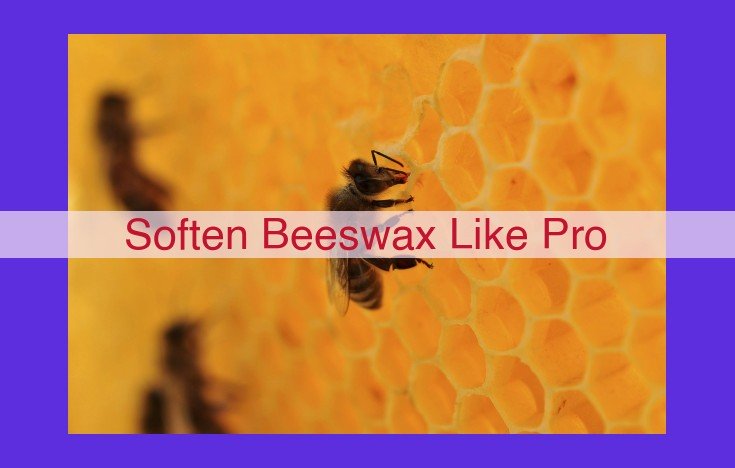Mastering Beeswax Softening: Ultimate Guide For Creative Applications
Master the art of softening beeswax seamlessly with our comprehensive guide. Understand the science behind beeswax’s softening behavior and explore various techniques, including the double boiler method, microwave method, and heat gun method. Learn tips for achieving the desired consistency, ensuring safety, and experimenting with different approaches to find the one that suits you best. Our expert guidance will empower you to soften beeswax like a pro, unlocking endless possibilities for your creative projects.
Understanding the Fundamentals of Softening Beeswax
Beeswax, a natural and versatile substance, offers a wide range of applications, from crafting to skincare. Softening beeswax is a crucial step in preparing it for various uses. By understanding the fundamentals of beeswax softening, you can achieve the desired consistency for your specific needs.
Temperature:
Temperature plays a pivotal role in softening beeswax. The higher the temperature, the faster the beeswax will soften. However, it’s essential to avoid overheating, as this can lead to changes in its properties.
Duration:
The duration of heating also impacts the extent of softening. Longer heating times result in softer beeswax. To achieve the desired consistency, it’s crucial to find the optimal balance between temperature and heating time.
Desired Consistency:
Depending on your intended use, you may require different consistencies of beeswax. From soft and pliable to slightly hardened, the desired consistency can vary. Adjusting the temperature and duration of heating allows you to achieve the ideal texture for your project.
Safety Precautions:
Beeswax is flammable, so it’s essential to prioritize safety when softening it. Always work in a well-ventilated area and keep the beeswax away from open flames or heat sources. Use appropriate heating methods and avoid overheating.
Methods for Softening Beeswax
Softening beeswax is a crucial step in preparing it for various applications, including candle making, skincare products, and woodworking. The process involves gently heating the beeswax until it reaches the desired consistency, and there are several effective methods to achieve this.
Double Boiler Method
The double boiler method provides precise temperature control while softening beeswax. Fill the bottom part of a double boiler with water and bring it to a simmer. Suspend the top part over the simmering water and add the beeswax to it. The indirect heat will gently melt and soften the beeswax without scorching or overheating it.
Microwave Method
The microwave method is a quick and convenient way to soften beeswax. Place the beeswax in a microwave-safe container and heat it in short bursts of 10-15 seconds at a low power setting. Stir the beeswax periodically to ensure even heating. Use caution not to overheat the beeswax, as it can burn easily.
Sun Exposure Method
The sun exposure method is a natural and eco-friendly way to soften beeswax. Place the beeswax in a clear glass jar or container and position it in a sunny location. The solar radiation will gradually heat and soften the beeswax over time. This method is best suited for small quantities of beeswax and requires patience, as it can take several hours or even days to achieve the desired consistency.
Heat Gun Method
The heat gun method allows for precise and localized heating of beeswax. Use a heat gun on a low-temperature setting and move it slowly over the surface of the beeswax. This method is ideal for softening specific areas of beeswax, such as edges or intricate details.
Hot Water Bath Method
The hot water bath method is suitable for softening small quantities of beeswax. Fill a heat-resistant container with hot water and submerge the beeswax in it. The hot water will transfer heat to the beeswax and gradually soften it. Stir the beeswax occasionally to promote even heating.
Air Fryer Method
The air fryer method offers versatility and precise temperature control. Place the beeswax in an air fryer-safe container and set the temperature to a low or medium setting. Heat the beeswax for a few minutes, checking the consistency periodically until it reaches the desired softness.
Remember to experiment with different methods to find the one that works best for your specific needs. Monitor the temperature, duration, and desired consistency closely to achieve the optimal results. Safety should always be your top priority when working with heated beeswax.
Tips for Successful Beeswax Softening
Whether you’re a seasoned craftsman or embarking on your first beeswax adventure, achieving the perfect consistency for your project can be crucial. Here are a few tips and tricks to ensure successful beeswax softening:
Experimentation: Explore Your Options
There’s no one-size-fits-all method for softening beeswax. Different techniques work better for different quantities and desired outcomes. Don’t be afraid to try out various methods until you find the one that satisfies your needs and yields the perfect consistency.
Attention to Parameters: Temperature, Duration, and Consistency
Remember the “3 Ds” of beeswax softening: duration, desired consistency, and temperature. These factors are intertwined and impact the final result. Experiment to discover the ideal combination that achieves your desired softness and pliability. Keep in mind that the desired consistency can range from soft and pliable to slightly hardened, depending on your intended use.
Safety First: Prioritize Precautions
Beeswax is flammable, so safety should always be your top priority. Avoid overheating and keep a close eye on the softening process. If using a microwave, monitor the heating intervals to prevent potential combustion. When handling heated beeswax, use heat-resistant gloves and work in a well-ventilated area.
